
Geothermal energy is derived from underground reservoirs of hot water or steam. Utility-scale geothermal projects tap into hot water or steam deposits, or into subsurface areas of hot, dry rock to which water can be injected, to spin a turbine. The Renewable Energy Program focuses primarily on utility-scale geothermal projects designed to generate power.
Enhanced Geothermal Systems - These systems include a reservoir with hot dry rock. Energy is captured by injecting cool water over the rock surface, causing water to be converted to steam. Utility-scale geothermal energy production relies on this process of conversion to heated fluid or steam, which turns a turbine connected to a generator. Common geothermal power generation methods all re-inject remaining geothermal fluid back into the ground to replenish the reservoir and recycle hot water.
Please refer to the U.S. Department of Energy's Office of Energy Efficiency and Renewable Energy websites for a more detailed description of geothermal energy.
Technology-Specific Impacts
Geothermal energy accesses resources and captures energy in different ways, resulting in various natural, cultural and historical impacts. Geothermal technology generally involves drilling wells, water movement through piping systems, and cooling, all of which may have potential impacts to natural and cultural resources. Key impacts of geothermal energy production include water quality and use, land conversion and subsidence, and air pollution.
Water Quality and Use: While most water is re-injected into reservoirs after use, some is lost as steam so additional sources of water are needed to maintain water levels. Brine (which is typically a low quality, high temperature byproduct of geothermal processes) can contain dissolved compounds such as silica, sulfates, and carbonates, which would degrade water quality if mixing were to occur.
Land conversion and subsidence: The process of extracting large quantities of water and reinjecting it into the ground has the potential to cause subsidence (the sinking of land surface) and minor earthquakes. Additionally, the necessary infrastructure for geothermal systems may result in vegetation clearing, soil impacts (movement/removal, compaction, erosion), and wildlife disturbance. Earthquake risks resulting from geothermal systems must also be considered to avoid major fault lines and areas of high seismic activity.
Air Pollution: Geothermal systems may emit harmful gases including hydrogen sulfide, carbon dioxide, ammonia, methane, or boron. Hydrogen sulfide, for example, in addition to its distinct smell, can lead to acid rain, which may have detrimental effects on forest, vegetation, wildlife, soils, historic buildings, or monuments.
For more information on potential environmental, cultural, and historic resource impacts of geothermal energy technologies, please see the "Programmatic Environmental Impact Statement for Geothermal Leasing in the Western United States [6.6 MB PDF]," or visit the links below.
Related Resources
- NPS—Significant Geothermal Features & The Geothermal Steam Act
- Introduction to Geothermal Resources, U.S. Department of Energy
- Geothermal Power Plants - Minimizing Land Use and Impact, U.S. Department of Energy
Last updated: March 10, 2020
